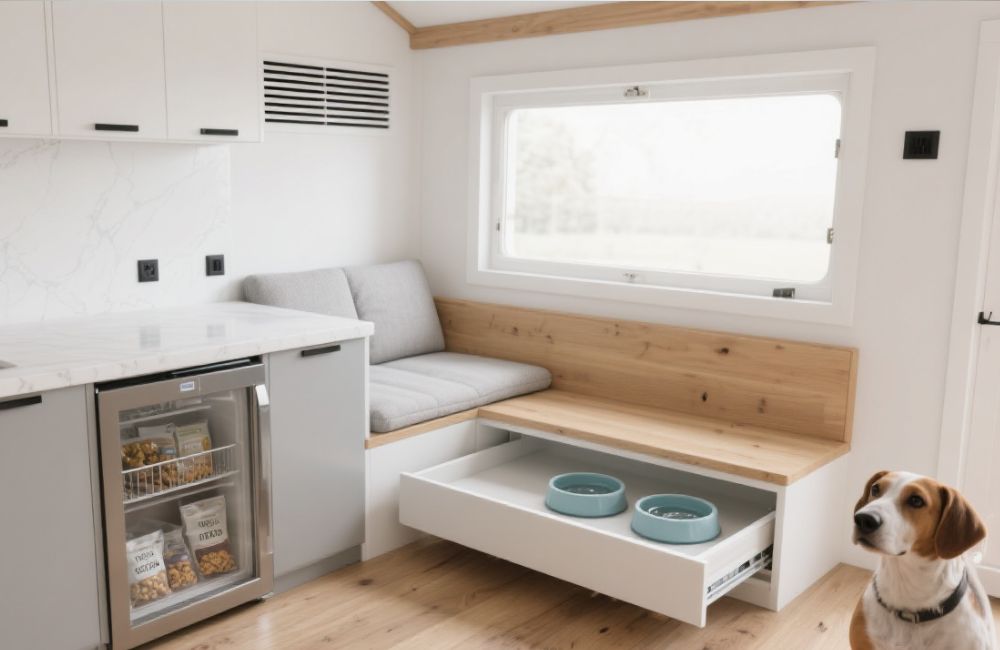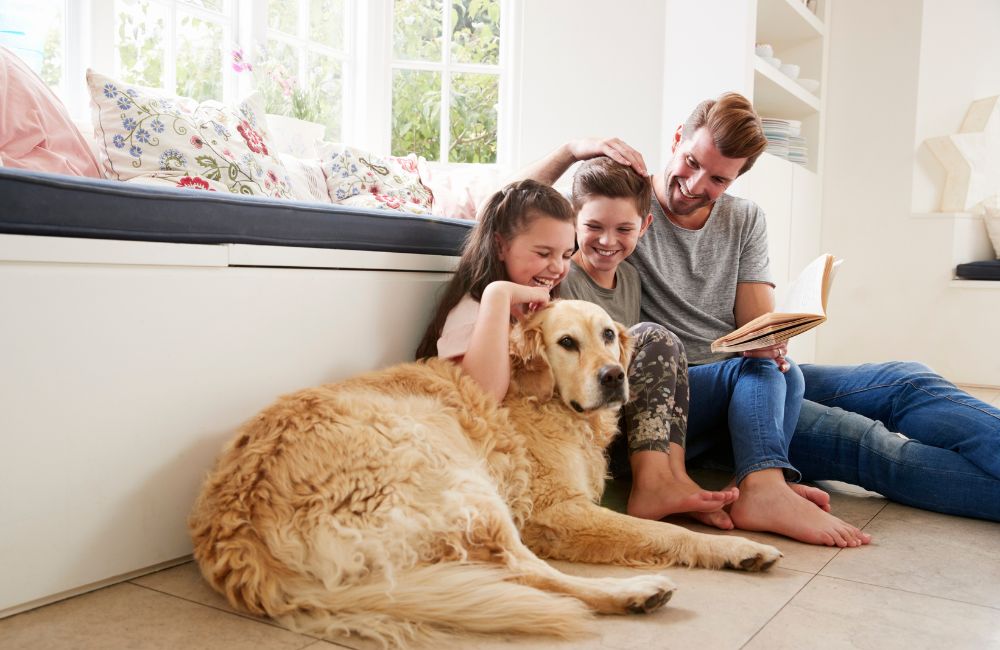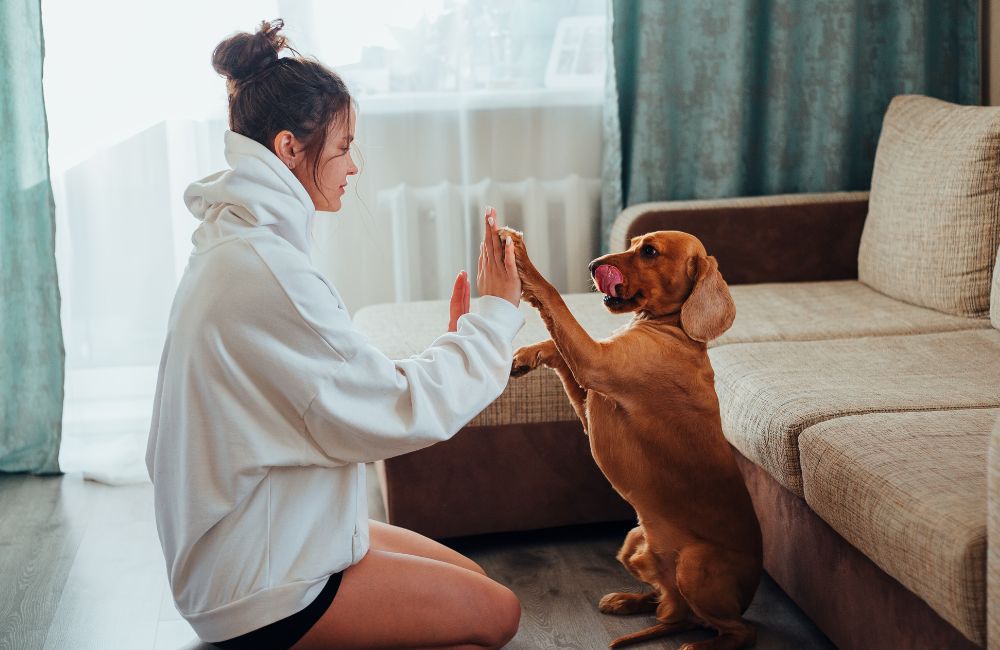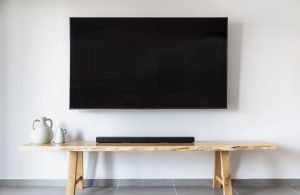Last Updated on October 30, 2025 by teamobn
Your home is tiny, your dog is mighty, and the floor plan leaves zero room for chaos. This pet zone blueprint turns inches into rituals that nourish, store, and streamline.
A small footprint doesn’t mean compromising your dog’s wellness or your home’s flow. The trick is designing one multi-tasking unit that handles seating, storage, feeding, and fresh food access, while staying beautiful.
Contents
- 1 What ‘Earning Its Footprint’ Really Means
- 1.1 Bench-Seat Storage With A Feeding Drawer
- 1.2 Collapsible Bowls And Smart Accessories
- 1.3 A Compact Undercounter Fridge For Get Joy
- 1.4 Ventilation And Hygiene In Tiny Spaces
- 1.5 Layouts And Measurements That Actually Work
- 1.6 Pet-Safe Finishes And Style Cohesion
- 1.7 Daily Routines And Training Integration
- 1.8 Budget And Build Options
- 2 Conclusion
What ‘Earning Its Footprint’ Really Means
In a small build, each element must solve multiple problems gracefully. Your pet zone should seat guests, stash gear, serve meals, and clean, all without stealing light, airflow, or movement.
When your seating doubles as pantry and feeding station, square inches do more. You’ll gain calmer routines, fewer spills, and faster cleanup, so your tiny home feels larger and more livable every day.
Bench-Seat Storage With A Feeding Drawer
Start with a full-depth bench with storage that anchors your pet zone and living area. Inside, divide storage for gear and food, and integrate a pull-out feeding drawer that positions bowls ergonomically.
Sizing And Ergonomics
Bench height between 17–19 inches suits most adults for comfortable seating. Plan a drawer front that hides bowls at a height your dog can reach without stooping, for medium dogs, that’s often 8–12 inches off the floor. Use soft-close slides, and spec a recessed pull so leashes and paws can’t snag. Ensure drawer travel clears rugs and door swings.
Drawer Construction And Materials
Build the box from moisture-resistant plywood with sealed edges. Line the interior with a removable silicone tray that has a raised lip to capture splashes. Cut precise circles or ovals into an inset plate to nest collapsible bowls securely. Choose a durable finish, such as waterborne polyurethane or conversion varnish, for wipeability without harsh odors.
Spill Management And Cleanability
Design for messes you’ll never dread. A tray that lifts out for the sink makes cleaning instinctive. Add a narrow gutter at the drawer’s rear to catch drips when bowls are lifted. Consider a washable, non-slip mat under the bench to protect flooring. Keep a towel and spray bottle stashed within arm’s reach to reset the station in seconds.
Collapsible Bowls And Smart Accessories
Collapsible silicone bowls shrink on demand, making your pet zone tidy between meals. Add a scoop, leash hooks, and a washable tray liner so everything resets after snacks and adventures.
What To Look For In Bowls
Choose food-grade silicone bowls with rigid rims so they hold shape when expanded. Check that the collapsed height fits your drawer’s clearance, and that the base won’t skate across the tray. Two sizes, water and food, cover daily needs, a third, shallow bowl is useful for toppers or thawed portions. Neutral hues blend into your cabinetry, keeping the look calm.
Accessory Docking And Organization
Mount two or three hooks at the bench’s side for leashes and harnesses. A slim magnetic strip inside the bench lid can hold a stainless scoop and a pair of shears. Use a small caddy for poop bags, wipes, and a microfiber towel. Label compartments so everyone in the household returns items to the same place without thought.
A Compact Undercounter Fridge For Get Joy
Get Joy is a fresh dog food brand that offers gently cooked meals made with real meat and vegetables, plus toppers and treats, all shipped frozen in pre-portioned packs for easy serving.
An undercounter fridge dedicated to fresh meals keeps routines seamless and your pet zone uncluttered. Size for Get Joy packs, add bins, and place it near seating to simplify prep.
Capacity And Temperature
Aim for a model that holds at least a week of meals in labeled bins. Confirm it maintains 34–38°F consistently and has strong door seals. Transparent bins help track inventory at a glance. Dedicate one bin to defrosting tomorrow’s portions. Keeping fresh food organized reduces waste and supports consistent nutrition with every serving of Get Joy.
Placement And Power
Tuck the fridge under the counter adjacent to your bench for a one-step workflow. Avoid corners that trap heat, leave clearance per manufacturer specs. If feasible, choose a panel-ready door to match cabinetry, hiding utilitarian looks. Run the unit on a surge-protected circuit and keep cord management tight to avoid snags in compact aisles.
Labeling And Rotation
Adopt a simple rotation: freezer to fridge to bowl. Label packs by day and AM/PM to eliminate guesswork. A whiteboard or small magnetic calendar inside a door keeps everyone aligned. First-in-first-out reduces surprises and makes grocery planning easier, log low inventory during the last portion of the week, not after it’s gone.
Ventilation And Hygiene In Tiny Spaces
Moisture, odors, and dander concentrate fast, so engineer airflow where your pet zone lives. Use cross-ventilation, low-VOC finishes, washable surfaces, and sealed storage to keep air fresh and routines healthy.
Passive And Active Airflow
Pair operable windows on opposite walls for cross-breezes, and install a quiet under-cabinet grille or toe-kick vent to keep air moving at floor level. A low-sone exhaust fan near the station helps after baths or messy meals. Avoid blocking vents with baskets or cushions. Even small moves, like a gap under the bench, help reduce stale pockets.
Low-VOC, Washable Surfaces
Select waterborne, low-VOC paints and sealers for cabinetry and surrounding walls. High-scrub, satin finishes survive frequent wipe-downs without looking shiny. For floors, consider sealed cork, porcelain tile, or waterproof LVP with tight seams. Keep grout lines minimal and choose a stain-resistant grout to avoid lingering odors and discoloration over time.
Cleaning Routines That Stick
Make cleanup painless so it actually happens. Store a dedicated caddy with enzyme cleaner, microfiber cloths, and spare tray liners under the bench. Set a recurring reminder to wash bowls nightly and deep-clean weekly. A ten-minute reset, wipe, swap liner, and refresh water keeps the area feeling brand-new and discourages pests in tight quarters.
Layouts And Measurements That Actually Work
Scale matters in a tiny footprint. Map paths, door swings, and bowl clearance so the pet zone never blocks movement. Measured inches can mean daily comfort, quiet, and fewer spills.
Clearance Cheats
Maintain at least 30–36 inches of walkway in front of the bench so the drawer can open without shoulder-checking guests. Keep a 3–4 inch toe-kick to protect doors from scuffs. If your living area is narrow, choose a shallow drawer and bowls that sit side-by-side rather than front-to-back to save depth while preserving access.
Traffic Flow And Quiet Zones
Situate feeding along a low-traffic wall to lower arousal during meals. Keep crates or beds a few steps away from seating so resting stays undisturbed. Avoid direct alignment with exterior doors to reduce draft and distraction. If your dog is noise-sensitive, consider soft-close hardware and felt bumpers to keep the ritual peaceful.
Pet-Safe Finishes And Style Cohesion
Design for durability without sacrificing beauty. Choose finishes that complement your palette, then make the pet zone feel native: matching fronts, wipeable cushions, and hardware that echoes handles elsewhere nicely.
Cushions And Fabrics
Opt for performance fabrics with moisture resistance and removable covers. A medium-density cushion (around 4–5 inches thick) balances sitting comfort with under-seat storage depth. Tight upholstery reduces crumb traps, piped edges hold up to frequent use. Keep a second cover on hand so one can be in the wash without leaving the bench bare.
Wood, Laminate, And Tile
Light oaks and matte laminates hide smudges and blend with Scandinavian palettes. If you prefer tile at the base, run it a few inches up the wall as a backsplash to catch splashes. Edge-band plywood carefully for longevity, or use prefinished panels to save finishing time. Repeat your kitchen’s hardware finish to unify the whole space visually.
Daily Routines And Training Integration
Design isn’t finished until behavior follows. Use the pet zone to cue sit-and-wait before meals, retrieve gear calmly, and reset toys nightly so your space recovers and mornings start smooth.
Meal Rituals
Build a predictable cadence: open fridge, portion, bowls down on cue, release to eat. Afterward, bowls get rinsed, tray gets wiped, drawer closes. Consistency reduces begging and pacing, and it protects floors from stray crumbs. Add a water refresh at the same time each day so hydration never becomes an afterthought during busy evenings.
Gear Reset
End every outing with a predictable dock: leash on hook, towel back in caddy, treat pouch in the top bin. This micro-habit prevents morning scrambles. If items creep beyond capacity, purge duplicates and keep one good version accessible. The clearer the reset, the more your system supports itself without constant reminders or weekend reorganizing.
Travel Days
On road-trip mornings, migrate pre-labeled portions to a small cooler while you pack. Collapsible bowls slip into side pockets, and the scoop rides with wipes and bags in the caddy. Returning home, reverse the flow. Unused portions go back to the fridge, and bowls get a quick soak. The same workflow makes overnights simple for pet sitters.
Budget And Build Options
There’s a path whether you’re DIYing or hiring. Break the pet zone into modules: pre-made bench carcass, custom drawer, and off-the-shelf undercounter fridge, then phase upgrades as budget allows comfortably.
DIY Path
Start with a ready-made bench box or IKEA base cabinet as the carcass. Add a plywood top, cushion, and a custom drawer with a silicone-lined tray insert. Use pocket holes and full-extension slides for straightforward assembly. If you’re new to cabinetry, templating the drawer cutouts with MDF and a trim router ensures crisp, professional-looking circles.
Pro-Help Path
A local cabinetmaker can adapt your exact dimensions and integrate ventilation grilles seamlessly. Share your appliance model and desired bin layout early. Ask for moisture-resistant cores, low-VOC finishes, and sealed seams around the tray. With a pro, you’ll get millimeter-precise reveals and fronts that perfectly match your existing doors and drawers for a cohesive, built-in look.
Phase Upgrades
Phase one: create the bench and basic drawer. Phase two: add the undercounter fridge and labeled bins. Phase three: integrate power for a nightlight or bottle-warmer-style defroster inside the cabinet. Final phase: refine finishes, swap to performance fabric, upgrade hardware, and add a matching end panel so the whole assembly reads like original millwork.
Conclusion
Small space living sharpens design choices. When the pet zone works as furniture, pantry, and ritual, your home feels larger, calmer, and kinder to your dog, and to your daily energy.
A single, integrated unit can simplify mealtimes, tame clutter, and anchor your living area without visual noise. Thoughtful airflow and washable finishes keep the air fresher and cleanup painless. With a compact fridge for fresh meals, routines become easy to repeat and share. Build once, then enjoy a calm, dog-forward home that truly fits your life.






